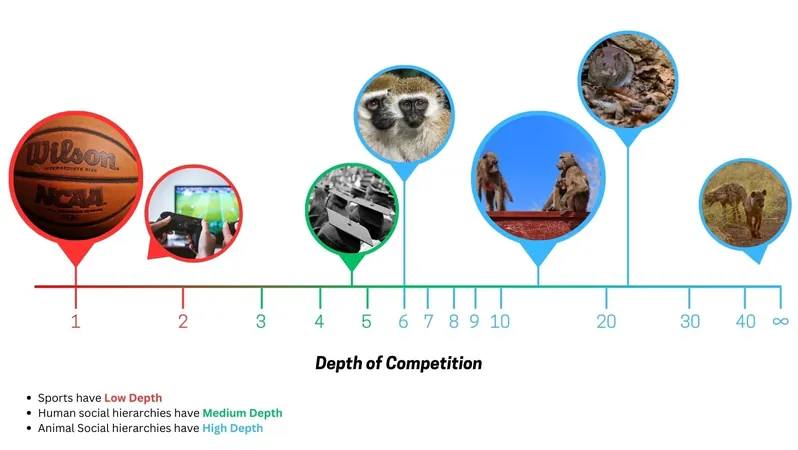
Unveiling the Depth of Competition: How New Research Reframes Our Understanding of Sports and Social Hierarchies
2024-11-06
Author: Wei
Introduction
Researchers at the University of Michigan have made a groundbreaking addition to the way we analyze competitive environments, from sports to social hierarchies among humans and animals. Their research, recently published in the prestigious journal Science Advances, introduces a new concept termed 'depth of competition' which has wide-reaching implications across various fields.
Understanding Depth of Competition
This innovative metric allows comparisons across different types of competitions, helping to predict outcomes in sports, gauge consumer preferences, rank educational institutions, and even assess hiring practices. The team's model can process data from an array of settings, whether it involves strategic board games or encounters among wildlife, enabling it to understand the dynamics of any competitive interaction.
Goals of the Research
As Max Jerdee, a doctoral student in physics and co-author of the study, explains, 'The model doesn't differentiate between a dataset from sports or one from animal interactions. Our objective is to create a universal methodology for measuring inequality across diverse competitive landscapes.'
The Concept of Depth
The concept is straightforward: competitions that exhibit greater inequality have a deeper structure. In essence, a deeper competition features a pronounced stratification in skill and status among competitors. Interestingly, this metric reveals that human games and sports tend to fall on the 'shallower' end of the competitive spectrum.
Application in Sports
Mark Newman, a professor of physics and complex systems at U-M, clarifies this notion: 'Take basketball, for instance. While it may seem like an unequal or shallow sport due to the vast differences in player ability, it's engineered for competitiveness across various skill levels. However, pitting a high-schooler against a professional NBA athlete wouldn't yield much excitement.'
Insights from Competitive Structures
The researchers further illustrate this point with the dynamics of competitive sports. In the NBA, teams with poorer performance records have improved chances of drafting promising young talent, thereby enhancing their future competitiveness. As Jerdee points out, describing something as 'shallow' could be interpreted positively, emphasizing the unpredictable and exhilarating nature of these contests.
Comparisons with Animal Kingdom
In contrast, in the animal kingdom, competition is often less nuanced. The term 'pecking order,' for example, refers to the clear dominance and hierarchy observed within chicken flocks. Stronger birds easily dominate their peers with little chance of being challenged, indicating a much deeper level of inequality—reaching a depth of approximately 20 layers according to Jerdee and Newman’s scale. In fact, the social hierarchy among hyenas can be even more pronounced, exhibiting a staggering depth of over 100 layers.
Human Social Hierarchies
Human social hierarchies, including dynamics within educational institutions or social circles in high schools, fall somewhere in between the competitive environments of sports and animal hierarchies.
Predicting Outcomes
Not only does the model assess the depth of competition, but it can also predict potential winners in various contests. This capability could revolutionize how we evaluate university rankings or forecast outcomes in sports events, providing clarity even in instances where competitors have no prior interactions. For instance, the model indicated that the University of Michigan's football team had an impressive 89% likelihood of defeating the University of Wisconsin had they faced off in 2022.
Implications and Conclusion
This pioneering research not only enriches our understanding of competition but also opens new doors for applications in sports analytics, economic forecasting, and social science. As we delve deeper into the nature of contention and hierarchy, we may soon uncover insights that challenge and redefine our perceptions of fairness and rivalry in both human societies and the animal kingdom.
Stay tuned for more updates on how these findings might influence various sectors, from sports to academia and beyond!


 Brasil (PT)
Brasil (PT)
 Canada (EN)
Canada (EN)
 Chile (ES)
Chile (ES)
 España (ES)
España (ES)
 France (FR)
France (FR)
 Hong Kong (EN)
Hong Kong (EN)
 Italia (IT)
Italia (IT)
 日本 (JA)
日本 (JA)
 Magyarország (HU)
Magyarország (HU)
 Norge (NO)
Norge (NO)
 Polska (PL)
Polska (PL)
 Schweiz (DE)
Schweiz (DE)
 Singapore (EN)
Singapore (EN)
 Sverige (SV)
Sverige (SV)
 Suomi (FI)
Suomi (FI)
 Türkiye (TR)
Türkiye (TR)